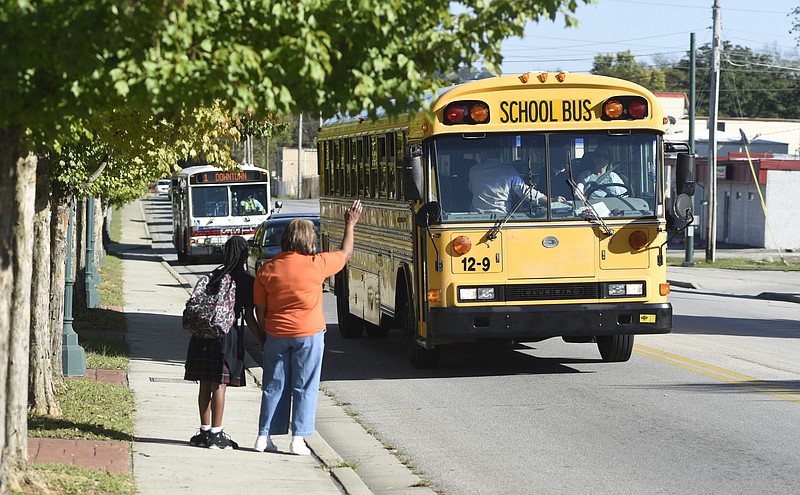If gang violence in Chattanooga began in the late 1980s or early '90s, then we are now seeing the second and third generation of gangbangers in our city.
The sins of the fathers haven't just been passed down; they have multiplied egregiously.
"These kids now are crazy," one man said.
"This generation?" another man said. "They're just like getting a pit bull that's already grown."
Last weekend was full of chaos, with back-and-forth shootings across the city. Tuesday morning, as kids gathered for school in Alton Park, the needle screeched off the record, and violence reached a new low.
A bus stop drive-by.
It was an act of both desperate strategy and strategic desperation. When 13-year-old Keoshia Ford was shot in 2012, it was a stray bullet from a block or two away. Tuesday, bullets were aimed at teenagers waiting to go to school. In the old days, when folks trespassed, they fought with their fists. Now, we have a bounty of guns and bus-stop violence.
"It's going to get worse before it gets better," one woman said.
One of the two suspects is an adult, but adolescent and preadolescent gangbangers are normal now, folks say. And they are more violent, more reckless, more unreachable. In the language of abandonment and resignation, with hopelessness a subtheme in nearly all they say, folks hang their heads over this new generation, as if mourning them while they're still living.
Their young, prepubescent bodies and brains are so soaked in trauma and normative violence, it's as if evolution - from fight-or-flight to prefrontal, from warrior to citizen, from street life to holism- is near-impossible.
These are our own lost boys.
"Best to skip right over this generation and start work on the next," one man said.
Once again, we face the question: What can be done? I think of A Better Tomorrow's Richard Bennett, once shunned by City Hall yet vindicated by the courts, and all the work he could have done for the city. Of Boyd Patterson and his epic gang study, of the great alignment of resources he was trying to pull together.
When and if Mayor Andy Berke runs for higher office, what will become of this current gang policy? What's the shelf life of the Violence Reduction Initiative? Will the next mayor keep the program or scrap it and start all over?
Can we afford such brief, short-lived policy? Out in the streets, one man mentioned seeing a boy no older than 3 or 4, already doomed.
"Throwing gang signs, pants hanging down," he said.
These aren't gangbangers.
They are more like child soldiers.
In war-torn countries across the world - like Yemen, Afghanistan and the Democratic Republic of Congo - hundreds of thousands of children are used, abducted, tortured and coerced to serve as child soldiers in wars and conflicts.
The U.N. defines a child soldier as anyone under 18 who has been recruited or used by an armed force or armed group. International law prohibits children under 15 from being used as soldiers; doing so is a war crime.
In the gangland of Chattanooga, that's everyday practice.
Recruitment often includes coercion, propaganda and the threat of violence. It happens against a backdrop of dire poverty and hopelessness. This is true from Chattanooga to Uganda.
Researchers with Patterson's 2012 gang assessment study - included online with this column - found that in this city, gang recruitment begins at a young age.
"3rd and 4th graders are being actively recruited," the study states. "Students as young as kindergarten are 'being exposed to gang related conversations, behaviors and activities they can tell you things you wouldn't believe about what they saw down the street.'"
The study recommends an interventionist model that surrounds younger kids with anti-gang programs and opportunities.
"The critical ages are 10-12 years, and these youth should be engaged in positive programs that reduce their vulnerability as targets for gangs," the study reports.
Ten to 12 years. Violence here is now prepubescent. Communities are in need of demilitarization; young bodies and souls beg for years of professional, rehabilitative care that deprograms and re-dignifies.
Overseas, international agencies work with geopolitical influence to reduce child soldiering.
Yet here?
Will anything change?
Yes, there are clear shortcomings with this comparison; abduction in South Sudan is not gang recruitment in East Lake. Yet both child soldiers and gangbangers are unspeakably victimized, and by reimagining one as the other - gang life as a form of urban child soldiering - we can wake up to the urgency and severity of preadolescent trauma in our city.
Contact David Cook at dcook@timesfreepress.com or 423-757-6329. Follow him on Facebook at DavidCookTFP.


